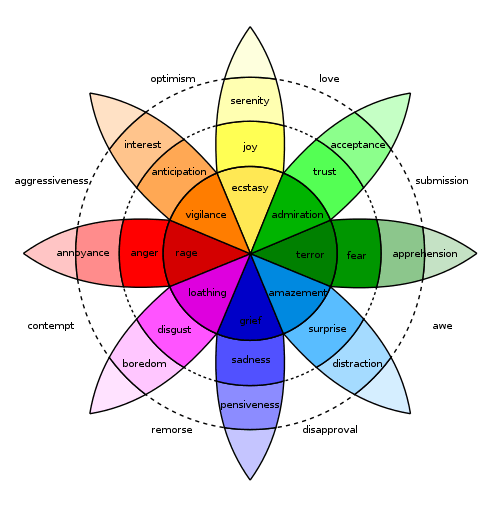Emotional reasoning
Emotional reasoning is a cognitive process by which a person concludes that his/her emotional reaction proves something is true, regardless of the observed evidence. For example, even though a spouse has shown only devotion, a person using emotional reasoning might conclude, "I know my spouse is being unfaithful because I feel jealous."
Emotional reasoning amplifies the effects of other cognitive distortions. For example, a test-taker may feel insecure about their understanding of the material even though they are perfectly capable of answering the questions. If he (or she) acts on his insecurity about failing the written test he might assume that he misunderstands the material and therefore might guess answers randomly, causing his own failure in a self-fulfilling prophecy.
Origin
Emotional reasoning, as a concept, was first introduced by psychiatrist Aaron Beck.[1] It was included as a part of Beck's broader research topic: cognitive distortions and depression. To counteract cognitive distortions, Beck developed a type of therapy formally known as cognitive therapy, which became associated with cognitive-behavioral therapy.[2] Originally, emotional reasoning was attributed to automatic thinking. Beck believed that emotional reasoning stemmed from negative thoughts that were uncontrollable and happened without effort.[2] This reasoning has been commonly accepted over the years. Most recently, a new explanation states that an "activating agent" or sensory trigger from the environment increases emotional arousal.[3] With this increase in arousal, certain areas of the brain are inhibited.[3] Combining the increase in emotional arousal with the inhibition of parts of the brain leads to emotional reasoning.[3]
Treatment
Before seeking professional help, an individual can influence the effect that emotional reasoning has on them based on his or her coping method. Using a proactive problem-focused coping style leads to more effectiveness at reducing stress and stressful events.[4] Additionally, having good social support also leads to lower psychological stress.[4] If one has to seek professional help, the most common therapy method is cognitive-behavioral therapy. In this approach, the automatic thoughts that control emotional reasoning are studied and realistically reasoned by the patient.[1] In doing so, the psychologist hopes to change the automatic thoughts of the patient and reduce his/her stress levels.[1] Cognitive behavioral therapy has been generally regarded as the most effective method of treatment for emotional reasoning. Most recently, a new therapeutic approach uses the RIGAAR method to reduce emotional stress.[5]
RIGAAR stands for:
- rapport building
- information gathering
- goal setting
- accessing resources
- agreeing strategies
- rehearsing success[5]
Additionally, reducing emotional arousal is also suggested by the human givens approach as a way to stop emotional reasoning.[3] As seen above, high emotional arousal inhibits brain regions necessary for logical complex reasoning. With less emotional arousal, cognitive reasoning is not diminished and the potential to not associate oneself with his or her emotions is stronger.
Implications
If not treated, debilitating effects can occur, the most common being depression.[6] On the other hand, emotional reasoning has the potential to be good when used to appraise the outside world and not ourselves. It is useful when one has to emotionally appraise something. Judging by how one feels when assessing the object, person, or event, it can be an instinctual survival response and a way to adapt to our world.[7] "The amygdala buried deep in the limbic system serves as an early warning device for novelty, precisely so that attention can be mobilized to alert the mind to a potential danger and to prepare for a potential of flight or fight".[8]
See also
References
- "Frequently asked questions". Beck Institute for Cognitive Behavior Therapy. 2011-09-19. Archived from the original on September 7, 2015.
- "The History of Cognitive Therapy". Beck Institute for Cognitive Behavior Therapy. Archived from the original on December 14, 2011.
- Shona Adams. "Human Givens Theory of Cognitive Distortions" (PDF). Archived from the original on 2015-10-10.CS1 maint: BOT: original-url status unknown (link)
- Taylor, Shelley E.; Stanton, Annette L. (April 2007). "Coping Resources, Coping Processes, and Mental Health". Annual Review of Clinical Psychology. 3 (1): 377–401. doi:10.1146/annurev.clinpsy.3.022806.091520. PMID 17716061.
- Linda Hoggan, Carmen Kane (2008). "Just what we need" (PDF). Human Givens Journal. 15 (2).CS1 maint: uses authors parameter (link)
- Knaus, William (1 June 2012). The Cognitive Behavioral Workbook for Depression: A Step-by-Step Program (Second ed.). New Harbinger Publications. p. 255.
- Lazarus, Richard (11 April 1996). Passion and Reason: Making Sense of our Emotions. Oxford University Press. p. 3.
- Kellogg, Ronald (16 July 2013). The Making of the Mind: The Neuroscience of Human Nature. Prometheus Books. p. 176.

